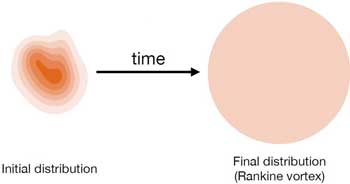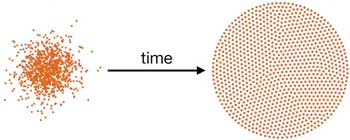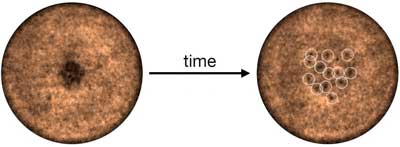| Sep 13, 2020 | |
Vortex top-hats emerge in superfluids(Nanowerk News) What has a top hat got to do with low energy electronics? The answer lies in superfluids, a state of matter in which a fluid can move without friction, and now an Australian-led study has shed new light on how these strange materials behave. |
|
| Superfluids contain spinning vortices (whirlpools) that can spin forever without losing momentum. Researchers found that clusters of these vortices, all spinning in the same direction, will form a ‘top hat’ shaped super-vortex. Understanding the behaviour of vortices in superfluids is key to FLEET’s search for electronic transistors that can switch from 1 to 0 with no resistance - a step towards ultra-energy efficient electronics. | |
| A defining feature of superfluids is that they exhibit quantised vortices – they can only rotate with one, or two, or another integer amount, of rotation. | |
| Despite this key difference from classical fluids, where vortices can spin with any strength, many features of the collective dynamics of vortices in both classical and quantum fluids are similar. | |
| However, in this study (Physical Review Research, "Universal dynamics in the expansion of vortex clusters in a dissipative two-dimensional superfluid") the FLEET team at the University of Queensland demonstrate one stark difference in the behaviour between classical and quantum fluids. The authors consider the expansion of vortex clusters to show that for any initial arrangement of quantised vortices, a ‘top-hat’ shaped super-vortex will form. | |
Why all superfluids ultimately become rankine distributions |
|
| “The behaviour of many vortices in a superfluid is often chaotic and difficult to describe theoretically,” explains lead author Oliver Stockdale. “Our study overcomes this challenge by providing an exact solution to the vortex dynamics.” | |
 |
|
| Figure 1. Expansion within a vortex fluid. A non-uniform vortex fluid expands to form a Rankine vortex (Darker colours represent high density). (Image: FLEET) | |
| The solution shows that a cluster of chiral vortices (vortices which all spin in the same direction) expands to form a constant density distribution that has a shape similar to a top hat. Such a distribution of vortices, known as a Rankine vortex, is forbidden in classical fluids due to their viscosity. | |
| “Superfluids have zero viscosity and can support a Rankine vortex”, explains Oliver. “The striking result of this finding is that all initial distributions of vortices, regardless of how they are arranged, expands to form a Rankine vortex. This demonstrates the mechanism for how a superfluid dissipates its energy via quantised vortices.” | |
| The authors employ a recently developed theory that describes the vortices themselves as a fluid. | |
 |
|
| Figure 2. A Gaussian initial vortex distribution expands to form a Rankine vortex (Numerical simulation). (Image: FLEET) | |
| “Just as hydrodynamics describes the behaviour of many fluid particles, it can be used to describe the motion of many vortices, which form a ‘vortex fluid’ within the ordinary superfluid,” says co-author Matt Reeves. | |
| “However, the vortex fluid exhibits additional ‘anomalous’ stresses; these extra forces arise due to the nature of the vortices that restrict their rotation to be quantised.” | |
| To support their theoretical findings, the authors simulate the dynamics of thousands of vortices computationally. As opposed to describing the vortices as a fluid, these simulations consider each vortex as an individual entity. | |
 |
|
| Figure 3. Rankine vortex emerges after cluster expands in experimental vortices (highlighted by white circles on the right). (Image: FLEET) | |
| Finally, the authors analysed data from an experiment that observed the expansion of a vortex cluster in a real superfluid, which was created using ultracold rubidium atoms. | |
| Not only did this study demonstrate the first solution to the complicated vortex fluid theory, it provided the theory’s first experimental test. |
| Source: ARC Centre of Excellence in Future Low-Energy Electronics Technologies (FLEET) | |
|
Subscribe to a free copy of one of our daily Nanowerk Newsletter Email Digests with a compilation of all of the day's news. |
